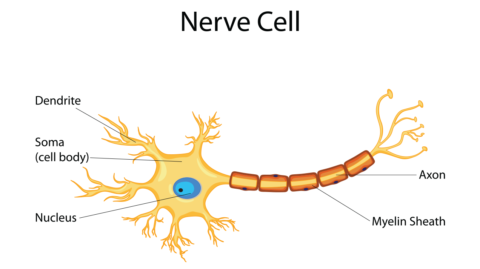What is MS?
Multiple sclerosis (MS) is a progressive disease of the central nervous system
Last updated: 10th April 2025
Multiple sclerosis (MS) is one of the most common diseases of the central nervous system (brain and spinal cord). Today more than 2.8 million people around the world have MS.
MS is an inflammatory demyelinating condition. This means it is caused by damage to myelin, which is the fatty protective coating that surrounds nerve fibres – a bit like the insulation on an electrical wire.

Diagram of a nerve cell identifying myelin
In the central nervous system nerve cells carry messages between the brain and spinal cord and the organs and limbs of the body. They control everything we do, from how we move to how we think and feel.
As well as protecting the fragile nerve fibres, myelin also allows messages to travel quickly along the nerves without being lost or interrupted. When myelin becomes damaged in MS, messages find it harder to get through – or can’t get through at all. That’s what causes the symptoms of MS. The places where myelin is damaged are called plaques or lesions, these areas appear as hardened (scar) areas: in multiple sclerosis these scars appear at different times and in different areas of the brain and spinal cord. The term multiple sclerosis means ‘many scars’.
MS symptoms can be very different for each person, depending on where in the brain and spinal cord the lesions can be found. MS symptoms vary widely and include blurred vision, weak limbs, tingling sensations, unsteadiness and fatigue. For some people, MS is characterised by periods of relapse and remission while, for others, it has a progressive pattern. For everyone with MS, it makes life unpredictable.
Quick MS facts
- There is currently no cure for MS, but treatments are available with can modify the course of the disease.
- More woman than men have MS – there are at least twice as many females (69%) as there are males (31%) living with MS, suggesting a role of hormones in the disease process.
- Diagnosis of MS is generally between 20 and 40 years of age, although onset may be at any stage in life.
- MS affects children as well as adults, with at least 30,000 people under 18 living with MS.
- There are a wide range of symptoms, with fatigue being one of the most common. Many MS symptoms can be successfully managed or treated.
- MS is not contagious or infectious.
- MS is thought to be caused by a combination of genetic and environmental factors.
- MS is not directly hereditary however, the risk of getting MS is higher in relatives of a person with the disease than in the general population.
- Although MS is found in all parts of the world, its prevalence varies greatly, being highest in North America and Europe, and lowest in sub-Saharan Africa and East Asia. It is found more commonly in countries further from the equator.
- MS is the most common disease of the central nervous system in young adults.
